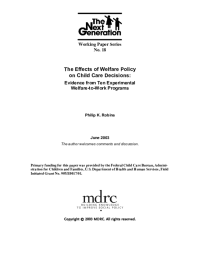The Effects of Welfare Policy on Child Care Decisions
Evidence from Ten Experimental Welfare-to-Work Programs
Summary of Key Findings for Working Paper No. 18
Background
One of the primary goals of the Personal Responsibility and Work Opportunity Reconciliation Act (PRWORA) has been to move welfare recipients into work and economic self-sufficiency. It is well known that child care costs often create a significant barrier to employment among parents with young children, particularly among low-income families receiving welfare or among families having a previous welfare history. Using data from four random assignment studies that tested ten welfare and employment programs, this working paper examines the impact of welfare reform policies on the child care decisions of families. Responses are measured for the combined sample of families participating in these programs as well as for each program separately. Responses are also measured separately for families that left welfare and for families that stayed on welfare during the study period.
Key Findings
- The ten experimental programs increased average employment by almost 7 percentage points. This impact was measured between two and four years after the programs began operating.
- The percentage of school-age children using any child care increased by about the same amount as the percentage of parents who were employed. Most of the increased child care was informal care provided by a relative, particularly by a sibling or a grandparent. There was also a small, statistically insignificant increase in the use of formal child care.
- There are significant differences in the employment and child care impacts across the various programs tested. The employment impacts ranged from -4 to +14 percentage points, and the child care impacts ranged from -3 to +14 percentage points.
- Although child care impacts are larger for welfare leavers (reflecting the larger employment impacts), they are not significantly different from the child care impacts of welfare stayers.
Conclusions and Implications
The results confirm expectations that welfare reform creates an additional need for child care. However, because most of the children studied here were of school age when their parents' child care choices were observed, the additional need was met mostly through informal sources, primarily care provided by relatives. Because care by a relative is often provided a little or no cost, the welfare reform programs did not create any additional program costs. However, current welfare reform programs that offer more generous child care subsidies could stimulate more employment and subsidy use among parents of children in this age group and, hence, could generate higher program costs.






